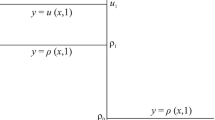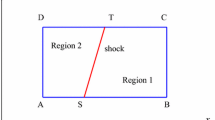Abstract
The Shock jump conditions for the Euler equations in their primitive form are derived by using generalized functions. The shock profiles for specific volume, speed, and pressure and shown to be the same, however, density has a different shock profile. Careful study of the equations that govern the entropy shows that the inviscid entropy profile has a local maximum within the shock layer. We demonstrate that because of this phenomenon, the entropy propagation equation cannot be used as a conservation law.
Similar content being viewed by others
References
Becker, R. (1922). Stosswelle und detonation. Zeitschrift für Physik, 8, 321–362.
Colombeau, J.F. (1990). Multiplication of distributions. Bulletin of the American Mathematical Society, 23, 2.
Colombeau, J.F., and Le Roux, A.Y. (1986). Numerical Techniques in Elastodynamics. Lectures Notes in Mathematics, vol. 1270, Springer-Verlag, Berlin, pp. 104–114.
Colombeau, J.F., and Le Roux, A.Y. (1988). Multiplications of distributions in elasticity and hydrodynamics. Journal of Mathematial Physics, 29, 2.
Farassat, F. (1994). An Introduction to Generalized Functions with Some Applications in Aerodynamics and Aeroacoustics. NASA TP-3428.
Hugoniot, H. (1889). Sur la propagation du mouvement dans les corps et spécialement dans les gaz parfaits. Journal de l'école polytechnique, 58, 1125.
Morduchow, M., and Libby, P. (1949). On a complete solution of the one-dimensional flow equations of a viscous, heat conducting, compressible gas. Journal of the Aeronautical Sciences, Nov., 674–684.
Rankine, W.J.M. (1870). On the thermodynamic theory of waves of finite longitudinal disturbances. Transactions of the Royal Society of London, 160, 277–288.
Richards, I.J., and Youn, H.K. (1990). Theory of Distributions. Cambridge University Press, Cambridge.
Smoller, J. (1983). Shock Waves and Reaction—Diffusion Equations. Springer-Verlag, New York.
Stokes, G.G. (1848). On a difficulty in the theory of sound. Philosophical Magazine, 3(33), 349–356.
Author information
Authors and Affiliations
Additional information
Communicated by M.Y. Hussaini
This research was supported in part under NASA Contract No. NAS1-19480, while the second author was in residence at the Institute for Computer Applications in Science and Engineering, NASA Langley Research Center, Hampton, VA 23681-0001, U.S.A.
Rights and permissions
About this article
Cite this article
Salas, M.D., Iollo, A. Entropy jump across an inviscid shock wave. Theoret. Comput. Fluid Dynamics 8, 365–375 (1996). https://doi.org/10.1007/BF00456376
Received:
Accepted:
Issue Date:
DOI: https://doi.org/10.1007/BF00456376




